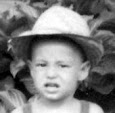
This is a 3 rib, 4.91 lb, USDA Choice Grade Standing Rib Roast. I decided to prepare it according to the procedure found at
The Virtual Weber Bullet Website. Thanks, Chris!

After sprinkling it down with Worcestershire Sauce, it was liberally coated with McCormick's Grill Mates Montreal Steak Seasoning, some really good stuff! (I added some more to the sides, after these pictures were taken.)

Then, it was wrapped tightly in Saran Wrap and placed in the refrigerator overnight.

The smoker's water pan was left empty and covered with aluminum foil. This will diffuse the direct heat, allow a higher cooking temperature with regular Kingsford charcoal briquets, catch any drippings, and make cleanup much easier.

After resting in the refrigerator overnight, the roast was allowed to sit out for a couple of hours before being placed in the smoker.

The smoker's dome temperature stayed between 325°F and 330°F for the entire 2 hour cook. I used a very small amount of Apple wood for a light smoke aroma and flavor. It turned out perfect!

The remote thermometer probe has been inserted into the roast and everything is ready to go!

Sometimes, the liquid sunshine conditions of The Great Northwest require one to take a few extra steps to get the job done. Hello, Honey!

The internal temperature of the roast is now at 54°F and the alarm is set to go off as soon as it goes above 125°F.

This roast took exactly 2 hours (about 24 minutes/lb) for the internal temperature to reach 126°F. It was then placed on a plate and covered with tin foil to rest for 30 minutes. During that time, the internal temperature continued to rise to 138°F.

A perfect medium-rare, all the way through. This was a very good beef rib roast.
 This is a 3 rib, 4.91 lb, USDA Choice Grade Standing Rib Roast. I decided to prepare it according to the procedure found at The Virtual Weber Bullet Website. Thanks, Chris!
This is a 3 rib, 4.91 lb, USDA Choice Grade Standing Rib Roast. I decided to prepare it according to the procedure found at The Virtual Weber Bullet Website. Thanks, Chris! After sprinkling it down with Worcestershire Sauce, it was liberally coated with McCormick's Grill Mates Montreal Steak Seasoning, some really good stuff! (I added some more to the sides, after these pictures were taken.)
After sprinkling it down with Worcestershire Sauce, it was liberally coated with McCormick's Grill Mates Montreal Steak Seasoning, some really good stuff! (I added some more to the sides, after these pictures were taken.) Then, it was wrapped tightly in Saran Wrap and placed in the refrigerator overnight.
Then, it was wrapped tightly in Saran Wrap and placed in the refrigerator overnight. The smoker's water pan was left empty and covered with aluminum foil. This will diffuse the direct heat, allow a higher cooking temperature with regular Kingsford charcoal briquets, catch any drippings, and make cleanup much easier.
The smoker's water pan was left empty and covered with aluminum foil. This will diffuse the direct heat, allow a higher cooking temperature with regular Kingsford charcoal briquets, catch any drippings, and make cleanup much easier. After resting in the refrigerator overnight, the roast was allowed to sit out for a couple of hours before being placed in the smoker.
After resting in the refrigerator overnight, the roast was allowed to sit out for a couple of hours before being placed in the smoker. The smoker's dome temperature stayed between 325°F and 330°F for the entire 2 hour cook. I used a very small amount of Apple wood for a light smoke aroma and flavor. It turned out perfect!
The smoker's dome temperature stayed between 325°F and 330°F for the entire 2 hour cook. I used a very small amount of Apple wood for a light smoke aroma and flavor. It turned out perfect! The remote thermometer probe has been inserted into the roast and everything is ready to go!
The remote thermometer probe has been inserted into the roast and everything is ready to go! Sometimes, the liquid sunshine conditions of The Great Northwest require one to take a few extra steps to get the job done. Hello, Honey!
Sometimes, the liquid sunshine conditions of The Great Northwest require one to take a few extra steps to get the job done. Hello, Honey! The internal temperature of the roast is now at 54°F and the alarm is set to go off as soon as it goes above 125°F.
The internal temperature of the roast is now at 54°F and the alarm is set to go off as soon as it goes above 125°F. This roast took exactly 2 hours (about 24 minutes/lb) for the internal temperature to reach 126°F. It was then placed on a plate and covered with tin foil to rest for 30 minutes. During that time, the internal temperature continued to rise to 138°F.
This roast took exactly 2 hours (about 24 minutes/lb) for the internal temperature to reach 126°F. It was then placed on a plate and covered with tin foil to rest for 30 minutes. During that time, the internal temperature continued to rise to 138°F.  A perfect medium-rare, all the way through. This was a very good beef rib roast.
A perfect medium-rare, all the way through. This was a very good beef rib roast.



















































